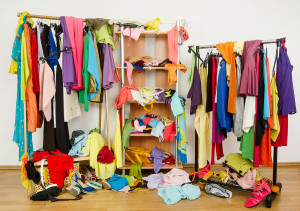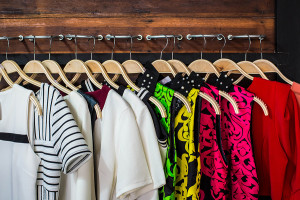Overcrowded and unmanageable clothing closets happen to everyone at some point in their life. As professional organizers, we have found that it is one of the top reasons our clients reach out for help. And it’s not hard to imagine how most people get into this situation; after all, shopping malls outnumber our high schools in the United States!
 There are lots of reasons why it is hard to deal with the closet overflow. For busy people, the idea of taking the time to thoroughly purge their closet can seem impossible. But, how high is this priority? According to our clients, it is one of their top goals! Of course, spending time with family, getting exercise and making accomplishments at work are important priorities. But, it is amazing how some of these other priorities are directly connected to organizing goals. Outer order controls inner calm.
There are lots of reasons why it is hard to deal with the closet overflow. For busy people, the idea of taking the time to thoroughly purge their closet can seem impossible. But, how high is this priority? According to our clients, it is one of their top goals! Of course, spending time with family, getting exercise and making accomplishments at work are important priorities. But, it is amazing how some of these other priorities are directly connected to organizing goals. Outer order controls inner calm.
De-cluttering clothing is a difficult task for many people. Clothing costs money; sometimes a little, sometimes a lot and it’s difficult to let go of that investment. Especially if it is something you haven’t even worn! To help you more easily edit your wardrobe and create space in your closets, we have come up with seven key questions to evaluate each garment when organizing your clothing.
#1: What’s the condition?
As you sort through your wardrobe, inspect the condition of each item. Look for pulls in fabrics, holes, excessive pilling on sweaters, broken zippers and fading or yellowing. This is an indication that something is tired and is a good candidate for donation or trash. Instead of trying to figure out how to wear a scarf cleverly to hide a stain or trying to pin broken zippers closed, give it up and make room for a newer item.
#2: Does it fit?
Dress the body you are walking around in now! Not the one you used to have or would like to have. If there is a feature of an item of clothing that you just don’t like, it won’t change. If the fit is wrong, even if the label reflects your size, it’s not right for you. When something is uncomfortable, don’t keep that item hanging around taking up space. If it doesn’t fit, it doesn’t fit!
#3: Is it in style?
Is the garment a classic piece or is it out of date? Does it have shoulder pads, it is bedazzled? Even though styles come back around, there are always details that have changed that make the original obviously original. The retail industry doesn’t want all of us to simply wait for the fashion to make its way around again. According to Psychology Today, Americans spend more on shoes, jewelry and watches alone ($100 billion) than on higher education! The fashion industry is going to keep churning out new styles and your clothing is going to keep going out of style, whether you like it or not.
#4: Is it practical?
Be honest – does the majority of what is in your closet reflect your lifestyle? If you work from home, or if your workplace is casual, consider how much “going out” clothing you need. If you wear casual clothes all day, then reduce your office attire down to a few classic staples or eliminate office attire altogether. However, your “casual” clothes should look and feel just as good as the “going out” clothing! So if you have lots of old, faded t-shirts and sweatshirts and innumerable black stretch pants, think about purging most of those old, tired standbys.
#5: Is it seasonally appropriate?
Every closet should have a revolving door. Keep your main closet in season and swap out fall/winter and spring/summer clothing twice a year. This will force you to handle all of your clothing and make decisions based on what was or was not worn during that season. When you are trying to put an outfit together, it will be much easier when you are not sorting through out of season clothing as well.
#6: Is it redundant?
Do you have multiples of similar items that you tend to favor over one another? Eliminate the similar pieces that you never wear. They may be similar, but you know which one is your favorite.
# 7: Is it you? In order to keep your pared-down wardrobe from growing again, you will need to start shopping smart – specifically, start being more selective.
When you are shopping, think about what you prefer in terms of styling. Do you like ¾ sleeves as opposed to long sleeved tops? Are you a minimalist or prefer monochromatic over prints? Consider features; if a pair of yoga pants has a fold-over waist, will you like that or not? If you stick to what you like once you have completed your wardrobe detox, you are more likely to avoid unnecessary and impulse buys.
 The availability of cheap clothing contributes to closet excess. Be careful not to purchase too many inexpensive items that add up to cheap and limited-life pieces. It’s easy to get caught up in deals or sales and before you know it, your cart full of items will become a closet full of items. There is nothing wrong with buying something inexpensive, as long as you love it! If you do, mix up your wardrobe with better quality pieces. They will fit better, the quality will likely be better and you will feel better when you wear them.
The availability of cheap clothing contributes to closet excess. Be careful not to purchase too many inexpensive items that add up to cheap and limited-life pieces. It’s easy to get caught up in deals or sales and before you know it, your cart full of items will become a closet full of items. There is nothing wrong with buying something inexpensive, as long as you love it! If you do, mix up your wardrobe with better quality pieces. They will fit better, the quality will likely be better and you will feel better when you wear them.
You can save the discount shopping for trendy styles you might want to try, but use caution not to overbuy in this category. These items will come in and out of style quickly and having to get rid of all of them in a year won’t make you happy, it’ll just make extra work.
Once you have edited your wardrobe down to items you only use and love, take it another step and swap out any plastic and dry cleaner hangers for slim, slip-free free hangers that hold onto clothing better and give your closet an overall improved, upscale look.
Follow these guidelines and you’ll have your wardrobe whipped into shape in time for a happy and organized spring!






